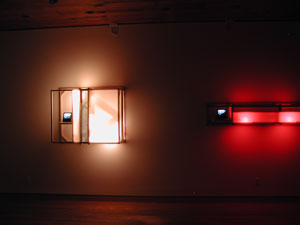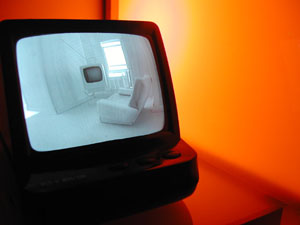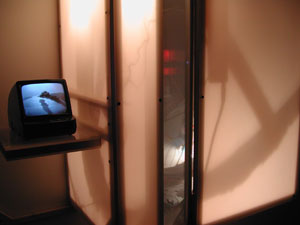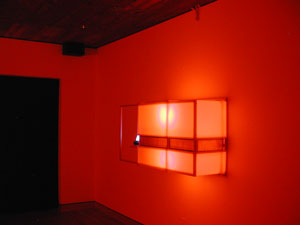In the past five years, through gifts and purchases, the museum's curators have acquired more than 4,000 works of art to bring the total count of the collection to 17,000 pieces.
The Blanton Museum of Art manages a vast permanent collection of Modern and contemporary American and Latin American art, European paintings, prints, and drawings. In the past five years, through gifts and purchases, the museum's curators have acquired more than 4,000 works of art to bring the total count of the collection to 17,000 pieces. The Blanton has consistently served a significant educational function, presenting teaching, research, and other opportunities to undergraduate and graduate students at the University of Texas at Austin, and to the public at large. The museum's collection, though not encyclopedic, includes many gems and demonstrates the visions of individual curators and collectors. However, the work has rarely been seen by the public and has spent most of the past 25 years between the Ransom Center, the University's art building, and storage. The new building, which boasts a controversial history, occupies an august location at the intersection of MLK and Congress. It is a permanent home for the museum's work. Though much of the collection will still live in the cool darkness of storage, the work will have many more opportunities for flexible display in the spacious, new facility.
The new building’s atrium invites loitering. Its ceiling stands 70 feet above in skylights of diagonals, bouncing rays from walls of Texas limestone. Throughout opening weekend, the atrium served a social function as the Blanton’s new center, its donut hole, and supported the warm arm of the downstairs galleries.The first gallery, to the left of the atrium, is a temporary exhibition space. Evidence of the Blanton's stated commitment to presenting cutting edge work outside the comfort of its own collection, the gallery currently displays the work of contemporary artist Paul Chan, a New York-based artist and activist. The gallery is deceptive; it feels intimate but it's roomy enough to accommodate Chan's deep explorations of compassion and hope in war and democracy. The exhibit presents 36 works, including a broad, two channel digital animation, My birds…trash…the future… (2004). With its repetitions and slow shifts of content, the work requires fabulous patience, eventually knocking you over with garish landscapes, lynchings, hunters and their soul-killing SUVs, and other detritus of modern American society.
Especially striking is Chan's 2nd Light (2006), a digital animation projected directly on the floor. Tucked in the back corner of the gallery space, it rewards those who wait for its slow change in post-apocalyptic color and content. Warm tones and cool abstractions gently move to black and white representations of falling bodies, a nearly unstirred tree, and the movements of those who have survived. The work is the artist's second in a planned series of seven, and it is a bold display for the Blanton in its showcase gallery.
Next to Chan's work, at the northern end of the building, is another room reserved for special exhibitions. Currently occupying the large, airy gallery is selected work from the museum's contemporary collection, an exhibition titled New Now Next: The Contemporary Blanton. It includes work by emerging and established artists in a various media, pieces recently displayed in the museum's old space, and new acquisitions from the thoughtful work of curator Annette DiMeo Carlozzi. The gallery is spacious and bright. It provides a lot of room for the work to breathe, especially for large-scale work like Fabian Marcaccio's Total Paintant (1999), a huge, mixed media meditation on the conventions of traditional art forms. The space also shows off the museum's outstanding contemporary art collection from Central and South America. On display and looking especially comfortable are Josefina Guilisasti's La vigilia (2001), a series of 72 oil paintings of aluminum pots, Jose A. Toirac's Díptico (En el desierto) (2000-2001), a black and white diptych of Castro, and Roberto Obregón's Disseciones reales no. 23 (1993), delicate repetitions of petals on paper.
Carlozzi oversees the Blanton's collection of Modern and contemporary American art, which includes more than 4,000 paintings, prints, drawings, sculptures, and new media. The group includes the Mari and James A. Michener Collection, paintings from the 1960s by artists such as Ellsworth Kelly, Alfred Jensen, Brice Marden, and Richard Tuttle. Recent acquisitions, either donated or purchased from specific funds raised, have filled out the collection with a diverse roster of artists, including Oliver Herring, Rachel Harrison, Amy Sillman, Dario Robleto, Jeremy Blake, Shahzia Sikander, Anne Chu, and Bill Viola.
Many of these recent acquisitions are currently on display in the large downstairs gallery. Robleto's Hippies and a Ouija Board (Everyone Needs to Cling to Something) (2003-2004) is a rich suitcase stuffed with dehydrated bone calcium, a Ouija board, homemade tonics, bottles, and 1960s records cast in prehistoric whalebone dust. The materials list is a catalogue of salves, many gentle options to lessen the hurt of history. The piece is comforting, like the basement of a love shack, but it's also unsettling, as we wonder how century-old hemlock oil and shark cartilage, two of many included ingredients, will soothe our hippie heartbreak. Another striking work is Emily Jacir's From Texas, with love (2002), a video of a flat West Texas landscape, captured from the front seat of a joy ride. Accompanying the image is an unusual soundtrack: Palestinian-born Jacir asked her countrymen what songs they would listen to, if they could drive uninterrupted across their homeland. She compiled their answers to fuel her desert road trip.
Hidden from the natural traffic of the first floor galleries and tucked behind the bathrooms is some of the most impressive work from the Blanton's arsenal. In a small alcove, stunning two-dimensional works by Joseph Beuys, Gerhard Richter, Jasper Johns, Robert Rauschenberg, John Baldessari and Willem de Kooning hang almost in secret, away from the maddening crowd. Beyond the alcove, the Center for Prints and Drawings occupies a modest position in the museum, despite (or because of) its renowned contents. With limited hours, the center displays selected prints from the Leo Steinberg Collection, as well as other acquisitions from the formidable eye of curator Jonathan Bober.
The white staircase to the second floor galleries is long and lean. Upstairs, to the right and left, two distinct and dissimilar “arms” display selected works from the museum's permanent collections. The Modern and contemporary galleries, on the right, include America/Americas, a permanent installation and painstaking integration of 125 Latin American and American works from the 20th century. Gabriel Pérez-Barreiro, curator of Latin American art, with the cooperation of his colleague Carlozzi, designed a thorough, innovative look at the similarities and dissimilarities between these artists from the upper and lower hemispheres. The chronological installation is vast and mind boggling: a brisk walk down the larger galleries starts with Modernist Abstraction and ends with Minimalism in a blink. Pérez-Barreiro is interested in the 'big picture' in his task as curator of Latin American art, but the arrangement here seems to rely too heavily on a predetermined art historical calendar. This presentation is curiously at odds with the curators' goal to create a flexible, fluid inspection of North and South American artists and their interrelationship. Certain work is still striking to see in the vast space, including Joaquín Torres-García's ode to abstraction, Constructif en rouge et ocre (Construction in Red and Ochre) (1931), and Luis Felipe Noé's Cerrado por brujeria (Closed for Witchcraft) (1963) , a stunner from the Nueva Figuración movement in Buenos Aires.
Though its presentation is often too broad, America/Americas is sweetened by companion work presented in the museum's smaller, interior galleries. Here the work is focused and narrowed around specific ideas. One room, at the southwestern end of the building, presents a series of conceptual work from the 1970s and 1980s, as a response to governmental repression in the United States and across the world. In Vito Acconci's Trademarks (1970/2001), a suite of seven black-and-white photographs and one text panel documents a performance piece of 1970. It shows the artist's attempt to bite the reachable parts of his own nude body. The last two prints in the series are narrow images of the bite marks, one filled with ink and pressed to a page. Here is the evidence of his actions close up. Acconci, like his contemporaries, often used the body in repulsive ways, launching body strikes to express disgust or protest specific political situations. And yet, his very public display of the private seems almost quaint compared to the work of Chilean-born artist Eugenio Dittborn. Sin rastros (pintura aeropostale num. 13) (1983) is a photo screenprint, an 'airmail painting,' designed to be sent through the postal service in a covert expression of political protest. The work is a response to the violence and censorship of the Pinochet regime, and features portraits of women who recall the multitudes lost or persecuted during this dark period. Side by side, the work of Acconci and Dittborn speak to a wide geographical gulf in the way artists could and would protest their country's injustices during these decades. The artists react in different yet equally self-sacrificing ways, and considering their work in tandem brings a new perspective to the history of political conceptualism.
Despite the seriousness of this work, it's hard to keep a straight face when you exit the southern end of the small gallery only to see the too-large dome of the Texas State Capitol framed by the Blanton's 'elounge' windows. This is cheeky, and even if it was an accident, it's a happy one. The elounge is a brief respite, and connects to a small gallery that will house the Blanton's Workspace exhibition series. Designed to be experimental, the program showcases the work of emerging and established contemporary artists, and currently has an installation by Argentina's Daniel Joglar. In 2006 and 2007, upcoming subjects include artists Carol Bove and Cristián Silva.
The second floor's second arm contains the considerable European galleries. The installation's design is similar to the Modern and contemporary galleries, with several large galleries of painting on the outside, lined by smaller galleries for prints and drawings. It allows movement back and forth between media and encourages hunting and picking for interrelationships. The current installation includes 150 Renaissance and Baroque paintings and 150 prints and drawings from the late 15 th century to the present.
Walking the new Blanton is easy. Even more attractive is the region at the top of the stairs, where visitors gather for a rest, to lean or watch the activity in the atrium below. Forming an airborne audience, these visitors make gentle companions with the large-scale Greek statues in lounge poses behind them. Here and throughout the museum, art and its viewers make comfortable bedfellows. Above all, this is a building for the public. But it's also a functioning residence for the university's art collection, where little distracts from the curators' collecting histories on display. The museum's calendar promises a vigorous exhibition program to compliment its distinguished holdings.
Full Disclosure: The author is a graduate of the Department of Art and Art History at UT Austin, and also contributed an essay about Fletcher Martin to the museum.
The Blanton's collection of Modern and contemporary Latin American art is renowned for its breadth. It includes the Barbara Duncan Collection, and encompasses more than 1,800 works by more than 600 artists.
The Blanton's European collection is staggering and beyond the scope of this article. It includes 300 European paintings (particularly strong in Italian Old Master works), 15,000 prints, and 1,500 drawings. The museum will rotate the exhibition of its prints every three months in thematic exhibitions.
Images courtesy Blanton Museum of Art.
Marie-Adele Moniot







